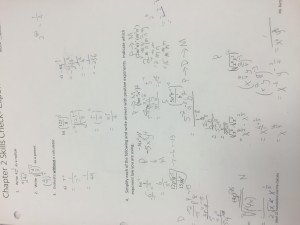1)
Politics
- Aboriginals forced to give up land for european settlers
- Colony and Community leaders often Loyalists or British officers
- Ruled by rich aristocrates
- upper class in charge
- lower class starting to demand democracy vs. upper class wanting to stay in power
- expected to conform or else cannot be in positions of power
- loyalty to Britain
- oligarchy (Family Compact)
Society
- barely any roads, everything was hard to reach
- it took a long time to clear the land
- there is an upper and lower society
- communities and social groups were dependent on each other
- majority of immigrants are lower class
- close knit communities
- colonists learn from First Nations
- religion central to culture
Economy
- this is a barter economy
- payments are done with goods like wood or wheat
- no currency
- fur trade was a big industry which was mostly controlled by Hudson´s Bay
- trade to overseas (for example Britain) via ship
- mortgage caused many people to be in dept
- land reserved for government and church
- most of the landlords were in Britain and just held on to the land to make profit
2)
Farming
In the picture we can see two men standing in an open space surrounded by trees. There is a path out of dirt with a cart on it. The cart is a cart for transporting wheat or other grains and is pulled by a horse. The field where the wheat come form is only a little field with barely enough grains on it to fill up that cart, but the farmer seems to make a living off the field and what he grows there. Another significance is that there are lots of tree stumps, so apparently he cleared the area by cutting down trees. The logs he could trade too, so that is a second way to make a living fir him. The two men look like they are in a handshake to finish a deal they just made. On of them, the one on the right, is well dressed and looks like he is part of the upper class, while the other man is not really well dressed, he might be lower class. That suggests that they are dependent on each other, because the farmer might trade the grains that he grows on his field to the land owner so he can us the land and live there. That is exactly what the textbook says about society and economy at that time.
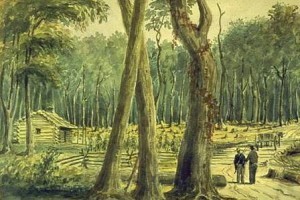
Social Class
This picture shows a city like it looked like in the 1800´s. There are no high buildings, no traffic lights or cars. There are coaches pulled by horses and some buildings. One of those buildings, the one in the centre of the picture, is big and in a bright color. It is also really big, so apparently it is owned by a member of the upper class. The buildings on the left side are smaller and look like they have not been painted in a long time. There is one door, but many units that all look the same, so there might be a lot of people living there together, each of them having not a lot of space for themselves. The people on the coaches that roll down the road are well dressed, so they might be the owner of the big and nice house or at least members of the upper class, while others are walking, maybe the people who live in one of the units in the apartment building. In the foreground of the picture there is a little hill and a river. Down at the bottom of the hill there are children playing in the mud, while above them, on top of the hill, there are people standing and talking. Those people, who are also well dressed, are looking at the playing children, maybe because it is their land. The children look like they arrant a part of the upper class, so maybe that is the reason why the people on the hill are watching them and might not want them to be there. The fact that the upper class looking people are standing above the children and appearing higher, supports that impression.
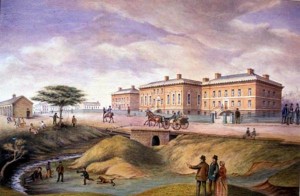
Religion
This picture shows Toronto in the 1800´s. There are people walking down the road, all in the same direction, so apparently they have one common destination. Significant is that people from the really big and nice houses on the left side of the picture that are connected to a good road, and the people from the smaller and less splendid houses are apparently walking to the same place. That place seems to be the church which is a big building in the centre of the town, with its big tower that can be seen from anywhere in town. It seems that religion was an important part of the peoples´ live in that time. They all are dressed nicely and families are together. In the other parts of the picture there are no people, just on the roads toward the church there are people. The textbook says religion was a central part of the culture and this picture supports that statement.
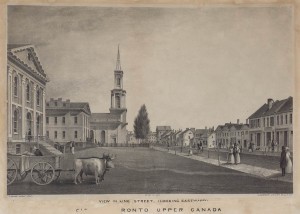
Land Issues
This picture show a group of tents within a forest. In the foreground there used to be lots of trees, but now there are only tree stumps, so most of that forest has been cut down. The two really high trees in the centre of the picture look like they are falling over, so maybe they are just being cut down in that scene. The forest is cut down by British settlers, which is shown by the British flag on on of the tents. Apparently the British cleared land to create a space for living and for building homes, a church and public institutions. The soil must be affected by the actions that were happening because all the trees, which have the shape of evergreen tress, have lost their needles, maybe due to a lack of nutrients in the soil. That is a problem that is still occurring as more and more trees are cut down, the whole ecosystem is affected. That picture partly agrees to the textbook. The textbook does say they clear land,but it says it took along time. In the picture it looks like they are cutting down the forest in a really short time.
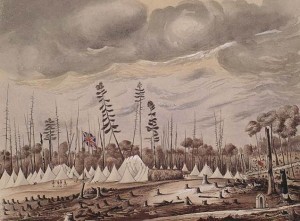
Sources:
http://myriverside.sd43.bc.ca/bchan/2014/02/17/224/

